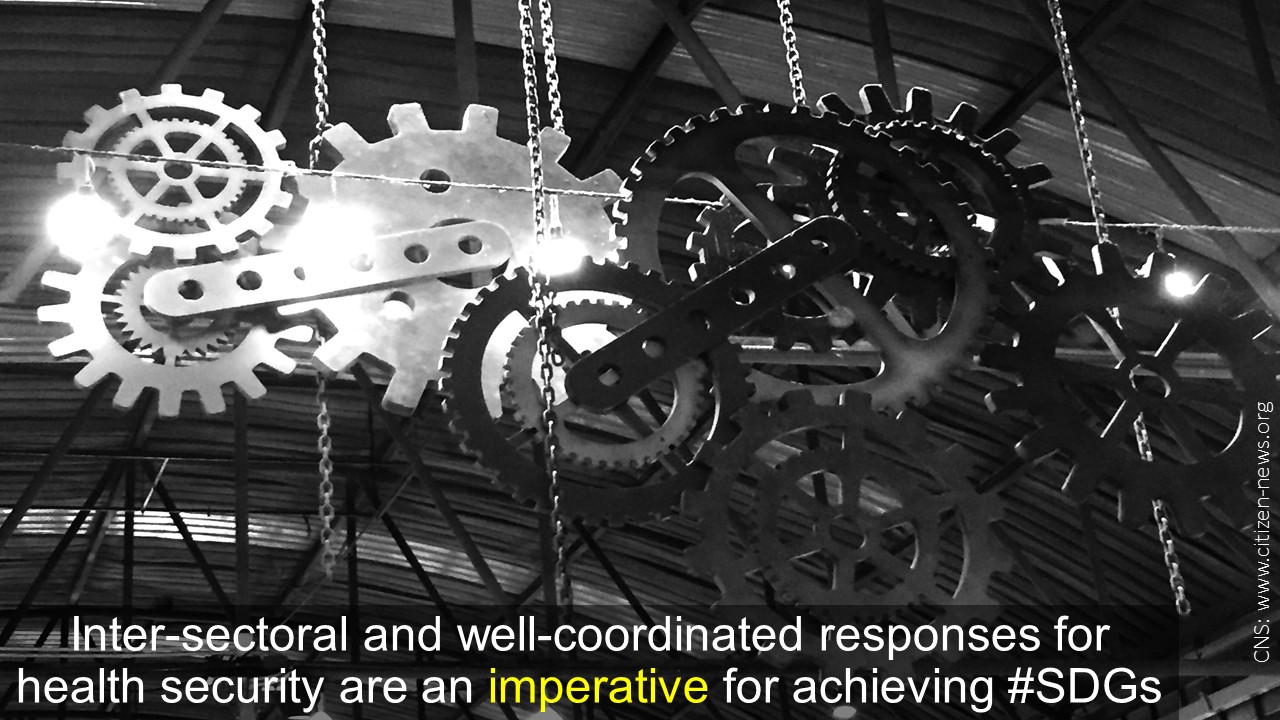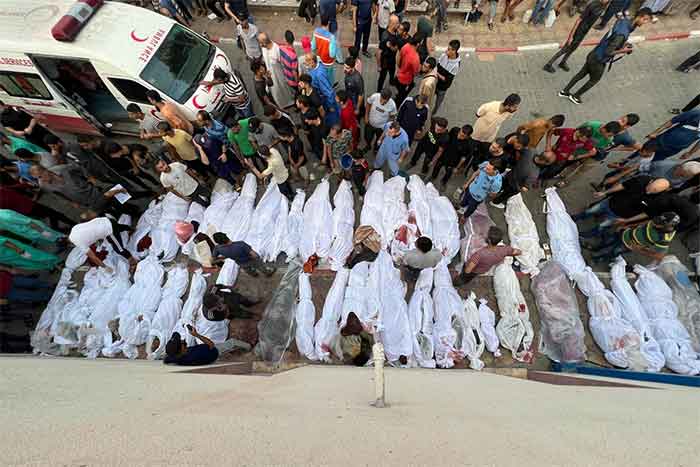
(CNS): When major weak-spots go beyond the purview of health ministry, inter-sectoral programming becomes critical to progress towards ending tuberculosis (TB) by 2030, globally. Indian government has committed to end TB by 2025 – a welcome political commitment indeed – but warrants urgent and unprecedented actions to muscle up the required pace to keep this promise.
As our governments meet at the ongoing 70th World Health Assembly (#WHA70) to decide the agenda for the World Health Organization (WHO) and to elect its new Director General, we do hope they also prioritise inter-sectoral programming beyond ministries of health so that TB declines at the required rate to end TB as envisaged. Current TB decline rates are a fraction of the required rate for TB decline in order to end TB by 2030.
Why interdependence is key to end TB
The wise words of Mahatma Gandhi, “Interdependence is and ought to be as much the ideal of human as self-sufficiency” provide a good compass when we think of ending TB. Scientific evidence shows that major risk factors for transmission of TB infection as well as those that jeopardize treatment are often beyond the purview of health ministries. If we are to end TB, we ought to ensure that there is no further spread of TB, as well as, every person with TB gets prompt access to accurate diagnosis and gets cured by effective treatment and support.
We slip backwards in fight against TB with each new infection transmission, and, every time we fail to accurately and timely diagnose, treat and cure TB. The journey to the #endTB finish line, consists of small but significant victories when we prevent TB transmission, accurately and timely diagnose each case of TB, treat the person promptly with effective treatment regimen and ensure treatment completion and cure.
Political will is firming up: globally and locally!
Governments of 194 countries globally have demonstrated their commitment to integrated development by adopting the UN Sustainable Development Goals (SDGs) in 2015. This is ‘no brainer’ that to succeed on any one of the seventeen SDGs, we also have to succeed on the remaining ones too. Healthy independence also warrants healthy interdependence to achieve shared visions and progress collectively towards common goals.
Even before SDGs got adopted, at the World Health Assembly 2014, the Ministers of Health of over 190 governments had approved the WHO End TB Strategy.
In addition to these global commitments to end TB, domestic political will is also firming up. India bears the highest burden of TB globally. Indian government’s National Health Policy 2017 promises to eliminate TB by 2025.
At 2017 World Health Day, the Himachal Pradesh state government announced to end TB by 2021-2022 at TB Free India Summit held in Dharamshala, Himachal Pradesh, India. TB Free India Summit organized by the Ministry of Health and Family Welfare of Government of India, International Union Against TB and Lung Disease (The Union) and partners, had brought together not just those involved in fighting TB but also other ministers, parliamentarians, Bollywood film-stars, cricketers, corporate private sector representatives, public sector representatives, scientists, media, TB survivors, among others.
Himachal Pradesh State Minister for Health and Family Welfare Kaul Singh Thakur announced that TB will get eliminated from Himachal Pradesh by 2021-2022 – few years before India’s commitment to eliminate TB by 2025. If every Indian state moves towards ending TB before national commitment to end TB by 2025, then only India will be able to keep its promises. Likewise if every country moves towards ending TB before 2030, then only the world will be able to eliminate TB by 2030.
Member of Parliament Anurag Thakur promised to go to every other state in India mobilizing them to make their state TB free before India can eliminate TB by 2025.
Jose Luis Castro, Executive Director of the International Union Against TB and Lung Disease (The Union) agreed: “To end TB in the world we must first end TB in India.”
MP Anurag Thakur quoted Prime Minister of India: “Correct and complete treatment of the disease [TB] is important to cure it.” MP Anurag Thakur stressed that although the TB programme began in 1962 but it still killed 480,000 in 2015. “These numbers should shock us in taking immediate and collaborative steps” said Anurag Thakur at the TB Free India Summit.
Rajiv Pratap Rudy, Minister of State (Independent Charge), Ministry of Skill Development and Entrepreneurship, Government of India, who till last year had the additional charge of Parliamentary Affairs Ministry, shared at the TB Free India Summit that two people close to him had got diagnosed with TB disease and eventually both got cured. One of them was his relative and the other person was among his staff.
India’s national Minister for Health and Family Welfare JP Nadda said at the TB Free India Summit that the fight against TB under the Revised National TB Control Programme (RNTCP) has come a long way in India and helped save lives. We cannot turn a blind eye on the fact that despite successes of RNTCP there are so many people suffering and dying of TB even today. We have a long way to go but with an aggressive strategy we will end TB by 2025.
JP Nadda shared that the National Health Policy (NHP 2017) released by India recently, aims to increase domestic health funding to 2.5% of GDP (from 1.2% currently). We also need to ensure that every state is fully utilizing the allocated budget for health. There should not be any unspent money from health budget, he said.
Nadda shared challenges confronting India’s fight against TB which included very low TB notifications from private sector despite TB was made a notifiable disease in May 2012, and unsatisfactory roll-out of Bedaquiline because of lack of optimal dispersing system. Nadda called for the need of a very active and robust system for dispersing drugs like Bedaquiline.
Looking ahead, later this year, a potentially game-changing Global Ministerial Conference is shaping up in Russia. Organized by the WHO and partners, this meeting will inform the High Level Meeting on TB at the UN General Assembly in 2018.
No one can do it alone: United to #endTB!
Risk of TB transmission as well as TB treatment outcomes both are dependent upon health systems as well as social determinants that directly influences public health. For example, malnutrition, poverty, migration, urbanization, sanitation and hygiene, gender disparities, economic and other inequalities in the society that marginalize communities, and a host of other development indices can impede TB programme outcomes.
Failure to avert every new transmission of TB infection and failing to diagnose, treat and cure every case of TB without any delay, push us backwards in our #endTB mission. We need to partner with everyone that can help prevent transmission of TB infection and help ensure early TB diagnosis, treatment and cure with ‘no one left behind’ becoming the reality on the ground.
“In the fight against TB, we need to focus more on social determinants” said Dalbir Singh, President of Global Coalition Against TB (GCAT) and a TB survivor who has been making countrywide efforts to engage parliamentarians and other sectors in the fight against TB. “Unless we address malnutrition, urban development, sanitation and hygiene, among other social determinants, we will fail to end TB” rightly warned Singh.
Agreed Dr Sunil Khaparde, Deputy Director General and head of Central TB Division, Ministry of Health and Family Welfare, Government of India: “Social determinants of TB pose big public health challenge” while calling for inter-sectoral responses to bolster the fight to end TB. Private sector engagement in TB control is very important as more than half of TB patients are going in private sector to seek care, said Dr Sunil Khaparde. There is some progress in engaging private sector in TB control after TB notification was made mandatory by the government of India in May 2012. More than 300,000 TB notifications came from the private sector but lot more needs to happen as this is indeed just the ‘tip of the iceberg’.
There are important government-run programmes on specific social determinants coordinated by a range of different government ministries and departments, as well as wide range of other development actors. Meaningful engagement of all actors, who can play a role in progressing towards ending TB, is undoubtedly a compelling public health priority.
Prevention cannot take a backseat
Dr Jamie Tonsing, South East Asia Regional Director of the International Union Against TB and Lung Disease (The Union) emphasized upon the risk factors that elevate the TB risk, such as diabetes, tobacco use, HIV, malnutrition, among others. She called for scaling up collaborative programming to address these risk factors to improve TB programme outcomes.
Another expert at the TB Free India Summit, Dr Masae Kawamura, Senior Director of Scientific and Medical Affairs, Qiagen, and senior member of Vital Strategies, pointed out “Without prevention we cannot accelerate the TB decline”. Addressing latent TB has to be a part of comprehensive strategy to eliminate TB.
We cannot put latent TB on blind spot, more so in high burden countries like India, when scientific evidence abounds for its effective treatment. We need to let scientific evidence, drive policy and programmes. There is no doubt that preventing TB is among the non-negotiable goalposts on the path to #endTB!
Ensuring standard infection control in healthcare facilities as well as communities and homes cannot be ignored if we are committed to end TB.
Could a vaccine be a silver bullet?
We have had a TB vaccine since almost one hundred years now: BCG (Bacille Calmette Guerin) which was first medically used in 1921. It is still being used for children in high burden nations. Even though BCG is the most widely used vaccine in the world, it has not successfully eliminated TB due to its very limited (but important) efficacy. There is no doubt that research and development for new vaccines would have the biggest impact on the epidemic, and remains the cornerstone for reaching global elimination within the coming decades. “Can we have better vaccines to prevent TB? Boosting research for more effective vaccines is an important priority” said Dr Srikanth P Tripathy, Director of National Institute for Research in Tuberculosis (NIRT), Indian Council of Medical Research (ICMR).
“Till research and development pipeline gives us a new effective TB vaccine, we need to realize that we currently have a good range of evidence-based methods to prevent, diagnose and treat TB, do infection control and provide care and support. Comprehensive TB prevention, control and care programmes are our present-day ‘vaccines’ in-hand – and we must implement these as efficiently as possible” rightly said Shobha Shukla, Executive Director of CNS (Citizen News Service).
Additional funding of USD 280 million pledged
Christopher Ben, Director (External Relations), Global Fund to fight AIDS, TB and Malaria (The Global Fund) said that “Finance and innovation are key and often interconnected as they may lead to each other.” The Global Fund has funded over USD 2 billion in previous years for fighting AIDS, TB and malaria in India. He announced a new additional funding of USD 280 million for TB over the next three years.
Empower those with greatest needs
Let’s hope the 70th World Health Assembly and the new Director General of the WHO will prioritise integrated responses to boost up health security globally. As Richard Horton, Editor-in-Chief of the Lancet, tweeted “Global health is about global democracy. But today nations with the greatest needs have the least power and influence. That must change.” Let’s keep the faith burning and striving for the desired change.
Bobby Ramakant is the Health Editor and Director (Policy and Communications) at CNS (Citizen News Service). He received the WHO Director General’s WNTD Award in 2008. Follow him on Twitter @bobbyramakant or visit www.citizen-news.org
- Shared under Creative Commons (CC) Attribution License
















































